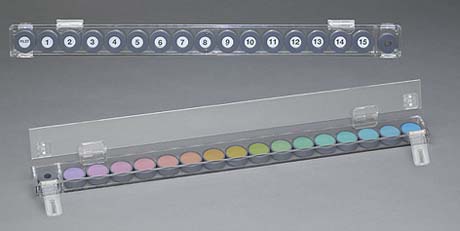Colour vision test

The Panel 16 Color Vision Test is similar to the well known Farnsworth Panel D-15 Test. In the Panel 16 test the colour surfaces are larger than in the Panel 15 test and thus measure colour perception in a larger area of the visual field. Since disorders affect colour vision in an irregular way, it is important to measure colour perception using test stimuli with different sizes. The large colour surface can be reduced to the standard size stimulus by using the gray circles included with the test.
Since in the Panel 16 test the coloured area is large, the test interests children more than the small caps of Panel D-15. The colour surface is covered with a thin protective coating and is therefore less likely to be destroyed if the child touches it.
When testing very young children two sets of the colour caps are used so that simple matching is possible:
- Place every third of the caps, six caps in all, on the table in front of the child.
Choose the pair of one of the six colour caps, show it to the child and ask whether the child has a cap with the same colour. Move the cap from one cap on the table to the next to allow the child enough time of comparing. Older children can hold the cap themselves. Visually impaired children often prefer bringing the two caps closer to their eye to still increase the size of the stimulus.
- You can train this test situation also as a computer GAME.

|
The concept of same/different can be trained by using pieces of material or, as here, by painting the surfaces of two wooden blocks in six different colours. The child turns the block to find the same colour as the one shown by the therapist. |
For assessment techniques see Testing Procedures, Older Children and Adults.
Paediatric Vision Tests I Vision Tests I Instructions Section I Main Page